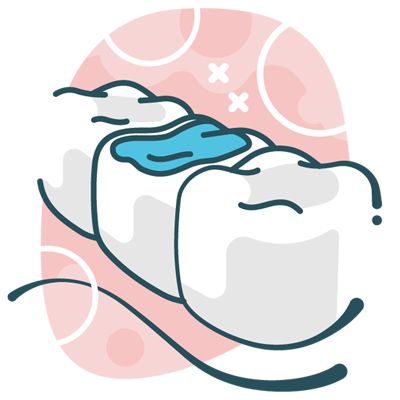Dental Fillings
Tooth decay is a bacterial infection. It can easily spread from tooth to tooth or eat its way deeper into your tooth structure if left untreated. The key is to intercept the decay as early as possible when tooth damage is minimal.
Symptoms of Tooth Decay
Routine X-rays allow us to screen for decay before symptoms become evident. Cavities between the teeth or around existing restorations need to be intercepted as early as possible. If you’re between checkups or haven’t seen a dentist in a while, watch out for warning signs, such as
- Tooth sensitivity
- Floss that shreds or gets caught
- Pain when eating/drinking something sweet
- Rough or sharp areas
- Visible darkening
- Food trapping
Yes! Tooth decay is the result of acidic bacteria and food debris accumulating on teeth. Daily brushing and flossing can prevent acid erosion and demineralisation. Early demineralisation can be reversed if caught early enough. Regular check and cleans-as well as fluoride therapy-and oral hygiene can help you reduce the chances of getting cavities between visits. Daily flossing is essential.
Do you have a small to a medium-sized cavity? Traditionally, we clean out the decay and fill in the hole with a small filling. In years past, traditional silver amalgam was used. Over time, composite-which is a type of plastic-has replaced metal fillings.
Unfortunately, composite does have its weaknesses. Since it’s weaker than natural tooth structure, the lifespan doesn’t last as long as we wish it could. Most plastic fillings last somewhere between 3-7 years or 10 if you’re lucky. They can leak or break without any symptoms leading up to it. And since it weakens the tooth each time we work on it, repeated plastic fillings can lead to eventual root canal and crown treatment.
Fortunately, porcelain inlays offer a more durable alternative. These lab-made fillings are ideal for large cavities, especially on back teeth due to the heavy force of use. Modern porcelain materials like e.max® and zirconia are stronger than teeth. They fit better, less likely to break and strengthen your tooth. The average porcelain inlay lasts 10-20 years with proper care.
There are still situations where plastic fillings are more appropriate. We’ll review our findings with you and discuss which options are available.
Our facility is equipped with an on-site ceramist and dental lab. Each of our porcelain inlays is handcrafted in our office for optimal fit and aesthetics. We also have an in-house CAD/CAM (CEREC) milling machine for digitally fitted same-day ceramic restorations like inlays or crowns.
Even if your tooth doesn’t hurt, a cavity can easily lead to nerve death. Some people experience visible symptoms or pain, but that’s not true for everyone. Decay should be removed as soon as it is diagnosed; otherwise, it will spread and compound your need for restorative care.
Decay in primary (baby) teeth is particularly detrimental, as it can spread at a rapid pace. Although your child will eventually get a permanent (adult) tooth to replace it, parents should take steps to prevent the decay from permanently harming underlying developing teeth.
Think You Have a Cavity?
Find out if porcelain inlays or dental fillings are right for you. Contact our office today for an exam.


